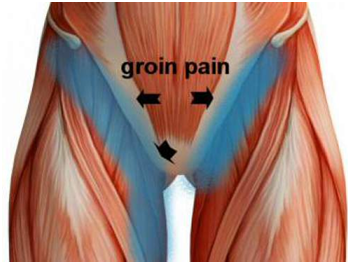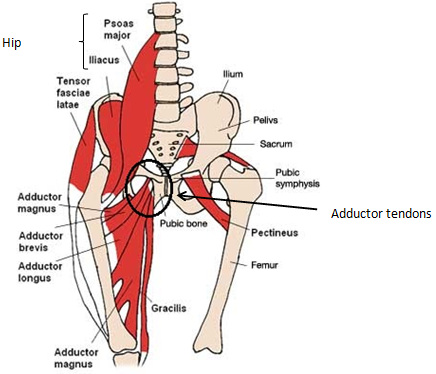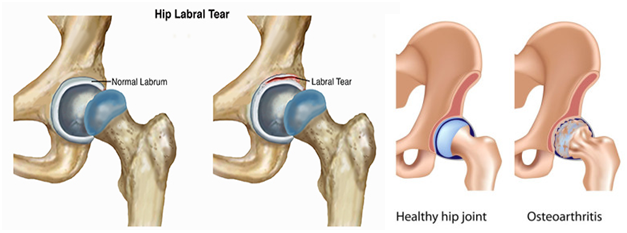With the pre-season kicking off for many sports, ‘groin pain’ is a common complaint that is reported to me by the athletes I work with. It often appears as either a gradual overuse injury (for example groin tendinopathy) or as a sudden acute injury (for example a groin muscle strain).
The actual term ‘groin’ is a label used to describe an area that includes the junction between your abdomen and the upper thigh on either side of the pubic bones. Even though we tend to commonly describe discomfort in this region as groin pain, the specific source of pain could be related to numerous different structures including muscle, tendon, ligament, joint, bone and nerves. Symptoms can be quite variable and are often vague and diffuse, which can make it difficult to pin point the underlying cause of the pain. Also to further complicate the issue there are often multiple pathologies co-existing in the athlete.

Below is a summary of the local pathologies that we frequently associate with groin pain:
ADDUCTOR MUSCLE STRAIN/TEAR:
The most common source of groin pain that people are familiar with is an adductor muscle strain. This occurs when the muscle has a sudden pull or stretch that leads to a breakdown of the muscle fibres. It is often involved with sports/activities that include a lot sprinting, sudden changes of direction and kicking. Signs and symptoms include acute pain over the muscle belly, swelling and occasionally bruising.
ADDUCTOR TENDINOPATHY:
Can occur through overuse or as a result of a previous injury, such as a groin strain; can come in the form of a reactive tendinopathy, which is an acute inflammation of the tendon, or tendinosis – a chronic tendon injury with degeneration of the tissue with no inflammation present. Signs and symptoms include pain at the point just below where the upper adductor muscles attach to the pubic bone. It is often described by patients as gradual onset of groin symptoms characterised by ache or stiffness in the area post activity.

HIP FLEXOR MUSCLE STRAIN/TEAR
Similar mechanism of injury to the adductor strain when the hip flexor (iliacus + psoas major) muscle has a sudden pull or stretch that leads to a break down in the muscle fibre tissue. Occurs more commonly in activities that involve sprinting or sudden high knee/leg lift, such as kicking. Although the signs and symptoms may be closely associated with an adductor strain, the treatment and rehabilitation plan involve many different components and types of exercises.
OSTEITIS PUBIS:
Overuse injury characterised by tissue damage and inflammation to the pelvis at or around the site where the two pubic bones join (pubic symphysis) resulting in groin pain. Common again in activities that involve repetitive running, kicking or change of direction, especially when there is an imbalance of muscles that attached to the pubic area which results in uneven and excessive load on the pubic symphysis. Signs and symptoms include pain over the pubic bone and adductors and usually require imaging to provide a definitive diagnosis.
HERNIA:
Tends to be a less frequent cause of groin pain. It is created by a defect of the abdominal wall in the inguinal region. This can cause abdominal contents to protrude through the hole in the wall causing a bulge and pain on side of your pubic bone. Pain in the groin may be increased by bending over, coughing or lifting.
Sports Herina is a term that people are becoming more familiar these days, but this not a true hernia. Involved in activities with sprinting, twisting, and quick change of directions, the injury occurs in the form of tears and weakening in the deep layers of the abdominal wall, but there is no herniation of abdominal contents. The signs and symptoms include pain in the groin with accelerating, twisting, turning, lifting, coughing or sneezing. Over time, if left untreated, it could develop into a true (inguinal) hernia.
HIP JOINT:
A number of acute or chronic hip pathologies can lead you to experiencing groin pain, but 2 of the most common causes are:
- Tear to the labrum – the labrum is ring of cartilage sitting around the edge of the hip joint. Its role is to help stabilise the hip joint. It most commonly is damaged by repetitive impingement at the hip joint, but can occasionally occur from a single injury such as high velocity movement at extreme ranges of the hip (kicking, twisting, slipping). Pain is in the front of the hip (most often in the groin area) and may be accompanied by clicking, locking or catching.
- Hip osteoarthritis (OA) – more common in the elderly population, hip OA is the wear and tear and eventual breakdown of the articular cartilage inside the hip joint. It results in swelling, stiffness and pain in the hip and groin area.

From the information we have just discussed you can now appreciate that not all groin pain is the same. It is an area of complex anatomy with the symptoms you are experiencing often being a combination of one or more of these structures. The underlying cause could be wide ranging including inappropriate training or techniques, poor biomechanics, poor pelvic and core stability and muscle weakness/tightness just to name a few. All these aspects and factors need to be addressed appropriately in order for a full recovery from groin pain. There are many ways RHP physiotherapists assess groin pain in athletes to determine which structure(s) are the source of pain and what the causes are. This then enables the best course of treatment and rehabilitation to take place.
To make sure you get the most out of your season leading into 2024, come in for some specific advice and rehabilitation of your groin pain from one of our experienced physiotherapists at RHP physiotherapy.
